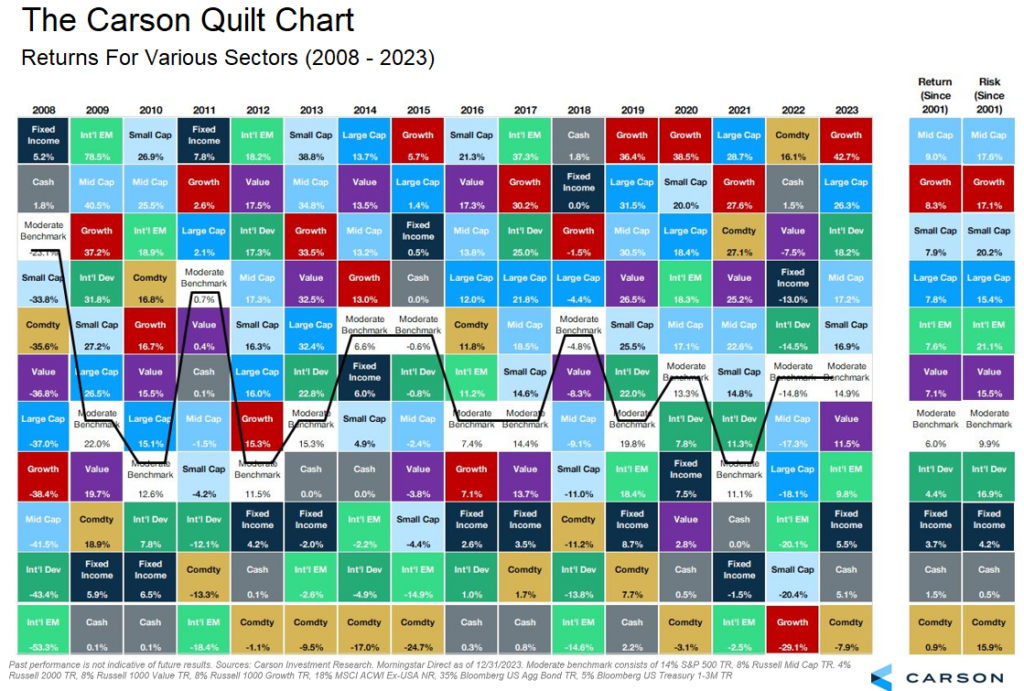Just like that, another year is in the books. No two years are the same, and every year something defies expectations. For most of the year last year, that was the stock market. Expectations for recession and a continuation of the dreary returns of 2022 were widespread. Investors were positioned for more pain – just the recipe for stocks to recover. What may be even more surprising was the huge turnaround in the bond market. An unloved asset class for all of 2022 and most of 2023, the broad aggregate bond index was negative for the year as recently as the beginning of November, only to rally 8.5% in the last two months of the year to finish with more than a 5% gain.
While reviewing performance of the past year can be informative for investors, zooming out and taking a longer-term view is even more important. The chart below is our version of the industry staple ‘Quilt Chart’ of asset class returns. We use the asset classes that make up our internal benchmarks (adding commodities), which also function as a neutral starting point for portfolio construction. We also include our moderate risk level benchmark (60% equity/40% bond target).
There is a significant amount of information – as well as lessons – that can be gleaned from looking at asset class returns over time.
Stocks and Bonds
Being a riskier asset class, textbooks tell us that stocks require a return above bonds to compensate for that additional risk. For that past 16 years this has been true. Bonds have only outperformed stocks broadly in 3 years – but in those 3 years you really needed bonds in your portfolio. No shortage of ink has been spilled about how bad 2022 was for multi-asset investors, but the beauty of bonds is that they are ‘self-healing.’ Higher interest rates as a result of price declines lead to better expected future returns, and a nice recovery in 2023, especially after all of the accrued income is realized.
Value and Growth
After being the worst performing asset class in 2022, growth stocks regained the crown as the top performing asset class last year, riding the wave of the “Magnificent Seven” mega-cap stocks. We’ve mentioned this mirror image of growth and value before, and it shows just how difficult it can be to time the style decision. Growth stock dominance over the past decade has many drivers, but often gets attributed to ultra-low interest rates, an environment that may have changed. Valuation differences between value and growth remain at extreme levels (in favor of value), and some traditional growth stocks have gravitated towards the value side of the ledger.
Domestic vs International
Similar to value, it has been a tough go for international markets for several years. In fact, developed international stocks have only outperformed domestic large caps in 4 of the 16 years listed, and have had higher volatility. Currency effects add an additional layer of complexity and volatility to investing internationally. That being said, markets overseas offer an opportunity set significantly larger, valuations significantly lower, and the opportunity for the right active manager to uncover the next big growth story.
Balanced Portfolio
Trends of the past may continue or could suddenly reverse. The only true guard against these changes is proper diversification. A balanced portfolio, proxied above by our moderate benchmark, will almost never be the best performing asset class, but surely won’t be the worst performing either. In fact, the balanced portfolio above was only in the top 3 on one occasion, and that was 2008. The volatility of the past 3-4 years is a great example of this. Commodities have moved from the worst performing asset class in 2020, to one of the best in 2021 and 2022, right back down to the worst performing last year. That kind of volatility on its own can be maddening, but additive when used and rebalanced into correctly.

Stay on Top of Market Trends
The Carson Investment Research newsletter offers up-to-date market news, analysis and insights. Subscribe today!
"*" indicates required fields
Looking at the big picture can better frame for investors the temptation to chase returns, give up on the worst asset classes, and highlight the need for active rebalancing.
As my colleague, Barry Gilbert, VP, Asset Allocation Strategist, noted in a prior blog, at Carson Investment Research we take a layered approach to portfolio management. Start simply and bring in depth as and when we think it will be rewarded. As you can see, there is a lot of room to create a more robust allocation, but beginning with a simple, solid foundation can also do a lot of work.
We believe that a simple, diversified starting point for portfolio construction with the added strategic and tactical decision making to favor asset classes with attractive characteristics – all while maintaining broad diversification – leads to the best long-term outcomes for investors. Here’s to 2024!
02066489-0124-A



